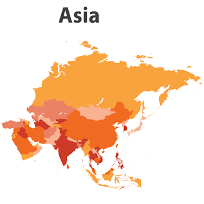Fidelity Asian Values plc (LON:FAS) is the topic of conversation when Hardman and Co’s Analyst Mark Thomas caught up with DirectorsTalk for an exclusive interview.
Q1: You called your recent report on Fidelity Asian Values ‘Asia: more appealing than ever’. What can you tell us about it?
A1: FAV’s performance is driven by stock selection, and that should never be overlooked. However, being in appealing markets gives favourable tailwinds, and, in this note, we highlight that Asia is now more appealing than ever, with i) growth accelerating into 2023 while developed economies slow, ii) lower inflation, iii) liberalisation of economies, iv) the full benefits of major new free trade agreements, and v) continued long-term positive demographic and urbanisation trends unaffected by short-term noise.
FAV may further benefit from sentiment increasingly favouring its small-/mid-sized value focus, a trend that, arguably, has already started.
Q2: You say Asia is accelerating into 2023 while Western economies are slowing. Can you put some numbers on that for us?
A2: The IMF’s World Economic Outlook April 2022 update highlighted the continued superior growth of the Asian economy over the rest of the world.
In 2022, emerging and developing Asia is forecast to have real GDP growth of 5.5%, against advanced economies’ estimated growth of 3.3%, while, in 2023, the gap is expected to widen to more than double, as Asian growth accelerates, while advanced economies are forecast to slow.
In 2023, the ASEAN 5 economies are expected to show real growth at just under 6% (India at just under 7%), while the US and the Euro areas are struggling at around 2%. Expected inflation in the G7 is around 6%, nearly double the Asian rate of 3.5%, with the associated interest rate risk being much higher in Western economies. The macroeconomic picture is much, much brighter in Asia.
Q3: And you touched on some new trade agreements and de-regulation. What can you tell us about them?
A3: The Asian Economic Integration Report 2022, produced by the Asia Regional Integration Centre (ARIC), has gone into some detail on the new trade agreements that are now effective across the region.
The Regional Comprehensive Economic Partnership (RCEP) became effective on 1 January 2022 and follows the Comprehensive and Progressive Agreement for the Trans-Pacific Partnership (CPTPP), which was effective at the end of 2018. The report notes that the RCEP will add $245bn to regional income and 2.8m jobs. In addition to free trade, we note that there is a general trend towards fewer regulations.
In India, under the tag line of “Reform, Perform and Transform”, there has been a broad range of changes, including sales tax systems, bank accounts and bankruptcy laws, and these have helped attract the highest-ever foreign direct investment.
Q4: And the long term demographics and urbanisation?
A4: The UN Habitat World Cities Report 2020 noted that 49%, nearly 1bn, more people in Asia will live in cities in 2030 than in 2010 (2.8bn vs. 1.9bn).
In our report, we included a chart that showed the proportion of the population who are urban dwellers. The starting position is very low relative to more developed economies. India has less than half its population in urban centres than is the case for the developed world, and China is around three quarters of that level.
The Kearney Consumer Wealth and Spending Study concurs with our view that, as consumers’ income and wealth rise, their spending habits change, with a much greater proportion of income spent on discretionary items, rather than basic necessities. It may be expected that this growth in spending will be focused in sectors such as financial services, consumer discretionary and leisure.
In addition, China will see a huge increase in the number of older people requiring more healthcare.
Q5: And what does this mean for the trust?
A5: Fidelity Asian Values’ performance is driven by stock selection, and that should never be overlooked. It is not a complicated story.
It invests in good businesses – not stocks, but businesses. It backs people in whose competency and honesty it trusts and buys at prices with a margin of safety. It does this again and again, and it doesn’t get carried away and doesn’t go to extremes – it just repeats the same behaviour, again and again.
It sounds quite boring, but by maintaining this discipline, with the Fidelity analyst team generating great investment ideas, and with the through-cycle support of the board, FAV has delivered long-term outperformance. Now, what we have done in this note is highlight that this approach is being undertaken in very appealing markets that give favourable tailwinds – a potential double whammy, if you like.


